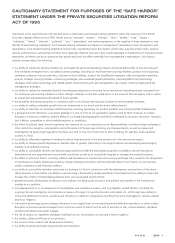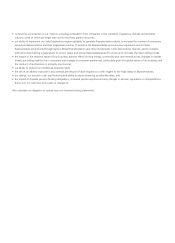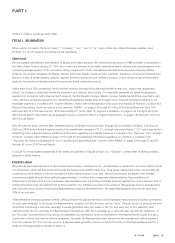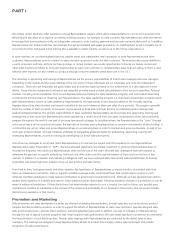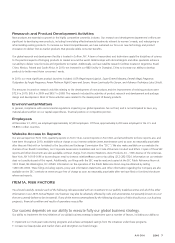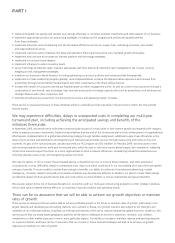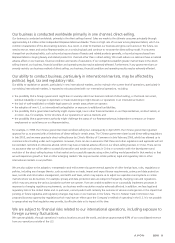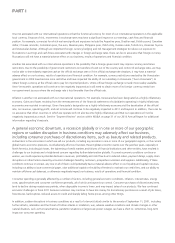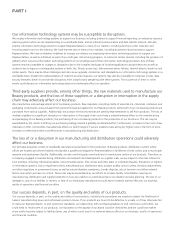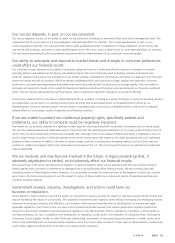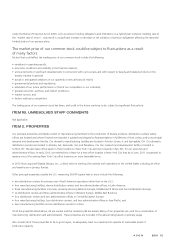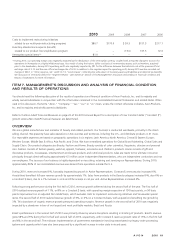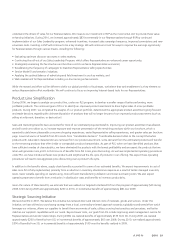Avon 2010 Annual Report Download - page 23
Download and view the complete annual report
Please find page 23 of the 2010 Avon annual report below. You can navigate through the pages in the report by either clicking on the pages listed below, or by using the keyword search tool below to find specific information within the annual report.We face significant competition.
We face competition from competing products in each of our lines of business, in both the domestic and international markets.
Worldwide, we compete against products sold to consumers by other direct-selling and direct-sales companies and through the Internet,
and against products sold through the mass market and prestige retail channels. We also face increasing competition in our developing
and emerging markets.
Within the direct-selling channel, we compete on a regional, and often country-by-country basis, with our direct-selling competitors. There
are also a number of direct-selling companies that sell product lines similar to ours, some of which also have worldwide operations and
compete with us globally. Unlike most other beauty companies, we compete within a distinct business model where providing a compelling
earnings opportunity for our Representatives is as critical as developing and marketing new and innovative products. Therefore, in contrast
to a typical consumer packaged goods (“CPG”) company which operates within a broad-based consumer pool, we must first compete for a
limited pool of Representatives before we reach the ultimate consumer.
Direct sellers compete for representative or entrepreneurial talent by providing a more competitive earnings opportunity or “better deal”
than that offered by the competition. Representatives are attracted to a direct seller by competitive earnings opportunities, often through
what are commonly known as “field incentives” in the direct-selling industry. Competitors devote substantial effort to finding out the
effectiveness of such incentives so that they can invest in incentives that are the most cost effective or produce the better payback. As the
largest and oldest beauty direct seller, Avon’s business model and strategies are often highly sought after, particularly by smaller local and
more nimble competitors who seek to capitalize on our investment and experience. As a result, we are subject to significant competition for
the recruitment of Representatives from other direct-selling or network marketing organizations. It is therefore continually necessary to
innovate and enhance our direct-selling and service model as well as to recruit and retain new Representatives. If we are unable to do so our
business will be adversely affected.
Within the broader CPG industry, we compete against large and well-known cosmetics and fragrances companies that manufacture and sell
broad product lines through various types of retail establishments. In addition, we compete against many other companies that manufacture
and sell in more narrow Beauty product lines sold through retail establishments. This industry is highly competitive, and some of our
principal competitors in the CPG industry are larger than we are and have greater resources than we do. Competitive activities on their part
could cause our sales to suffer. We have many competitors in the highly competitive gift and decorative products and apparel industries
globally, including retail establishments, principally department stores, gift shops and specialty retailers, and direct-mail companies
specializing in these products. Our principal competition in the highly competitive fashion jewelry industry consists of a few large companies
and many small companies that sell fashion jewelry through retail establishments.
The number of competitors and degree of competition that we face in this beauty and related products industry varies widely from country
to country. If our advertising, promotional, merchandising or other marketing strategies are not successful, if we are unable to deliver new
products that represent technological breakthroughs, if we do not successfully manage the timing of new product introductions or the
profitability of these efforts, or if for other reasons our Representatives or end customers perceive competitors’ products as having greater
appeal, then our sales and financial results may suffer.
Any acquisitions may expose us to additional risks.
We continuously review acquisition prospects that would complement our current product offerings, increase the size and geographic scope
of our operations or otherwise offer growth and operating efficiency opportunities. The financing for any of these acquisitions could dilute
the interests of our stockholders, result in an increase in our indebtedness or both. Acquisitions may entail numerous risks, including:
• difficulties in assimilating acquired operations or products, including the loss of key employees from acquired businesses and disruption to
our direct-selling channel;
• diversion of management’s attention from our core business;
• adverse effects on existing business relationships with suppliers and customers; and
• risks of entering markets in which we have limited or no prior experience.
Our failure to successfully complete the integration of any acquired business could have a material adverse effect on our business, financial
condition and operating results. In addition, there can be no assurance that we will be able to identify suitable acquisition candidates or
consummate acquisitions on favorable terms.
A V O N 2010 11


